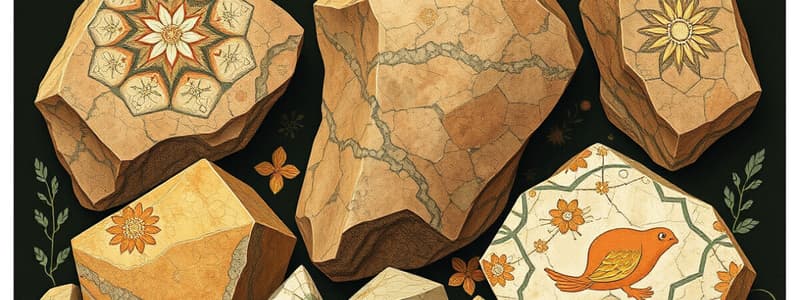Podcast
Questions and Answers
What are rocks made out of?
What are rocks made out of?
Mountains, valleys, and the sea floor are all made out of rocks composed of individual mineral crystals, broken bits of minerals, or rock fragments.
What helps geologists classify rock composition?
What helps geologists classify rock composition?
The minerals or grains present in a rock.
What are the three major types of rocks?
What are the three major types of rocks?
- Crystalline
- Igneous (correct)
- Metamorphic (correct)
- Sedimentary (correct)
How are igneous rocks formed?
How are igneous rocks formed?
What causes rocks to break down on Earth's surface?
What causes rocks to break down on Earth's surface?
What causes metamorphic rocks to form?
What causes metamorphic rocks to form?
What does the rock cycle describe?
What does the rock cycle describe?
What is magma?
What is magma?
What is lava?
What is lava?
What is sediment?
What is sediment?
What defines a rock?
What defines a rock?
What are grains in geology?
What are grains in geology?
What is texture in rocks?
What is texture in rocks?
Flashcards are hidden until you start studying
Study Notes
Overview of Rocks
- Rocks form the foundation of Earth's structure, comprising mountains, valleys, and the sea floor.
- Made up of mineral crystals, broken mineral fragments, or rock pieces.
- Weathering and erosion processes break rocks into various fragments.
Composition of Rocks
- Rock composition includes the minerals or grains that characterize each rock.
- Geologists use composition to classify rocks and deduce their formation environments.
Major Types of Rocks
- Three main rock types: igneous, sedimentary, metamorphic.
- Classification is based on formation processes, with each type reflecting different physical and chemical characteristics.
Igneous Rocks
- Formed from cooling and crystallization of magma or lava.
- Crystals grow and interconnect, forming the rock's grains.
- Typically develop in environments like volcanic areas, mid-ocean ridges, and subduction zones.
Sedimentary Rocks
- Created from the breakdown of existing rocks, transported via wind, water, ice, or gravity.
- Comprised of rock fragments, mineral crystals, and organic remains.
- Form in environments where sediment settles, such as riverbeds and lake bottoms.
Metamorphic Rocks
- Arise under extreme temperature and pressure conditions, usually near tectonic plate boundaries.
- Chemical fluids can also transform existing rocks into metamorphic ones.
- The mineral composition and texture of original rocks change during metamorphosis, applicable to igneous, sedimentary, or existing metamorphic rocks.
The Rock Cycle
- Describes the continuous processes that transform one rock type into another.
- Driven by surface and subsurface geological forces, with changes occurring slowly over time.
Rock Cycle Processes
- Certain processes take place underground, involving heat, pressure, and melting.
- Uplift brings rocks to the surface, where they are subject to further natural processes and weathering.
Definitions of Key Terms
- Magma: Molten rock found underground.
- Lava: Molten rock that erupts on the Earth's surface.
- Sediment: Material produced from the erosion of rocks into smaller pieces or dissolved in water.
- Grains: The individual fragments that constitute a rock.
- Texture: Refers to the size and arrangement of minerals or grains in a rock; crucial for rock classification.
Importance of Texture
- Texture is a key feature studied by geologists to classify rocks.
- Evaluation involves the size of grains, their arrangement, and the overall sensation of the rock.
- Helps in understanding the rock's formation environment and classifying igneous rocks effectively.
Studying That Suits You
Use AI to generate personalized quizzes and flashcards to suit your learning preferences.




